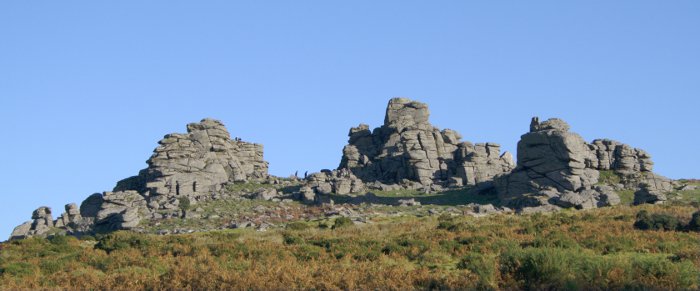
A modern Ordnance Survey map of Dartmoor shows us three tors with Hound in their name: two are simply called Hound Tor, while the third is Little Hound Tor. Of these, by far the most impressive is the one shown above. The two tiny human figures seen against the skyline give one a measure of the immensity of the exceptional granite rock formation that makes up the Hound Tor near Manaton on the eastern edge of the moor. The other two stand close to each other to the north of the moor.
Samuel Rowe in his Perambulation describes Hound Tor as "one of the most interesting of the tors on the moor". Impressed by the sheer scale of the outcrop, he continues:
William Crossing in Gems in a Granite Setting refers to its supposed Druidical significance to some noted 18th century antiquarians and their disciples:
Sabine Baring-Gould gives this somewhat fanciful explanation for the naming of the tor:
It has been suggested widely that Arthur Conan Doyle drew inspiration from Hound Tor for the plot of Sherlock Holmes' most famous adventure, The Hound of the Baskervilles[4]. Not so, according to Philip Weller in his comprehensive and entertaining background analysis of the story, The Hound of the Baskervilles: Hunting the Dartmoor Legend[5]. Weller gives three plausible reasons for rejecting any association between the Hound and the Hound Tor near Manaton.
In the caption to the image shown below of the tor and the nearby kistvaen (see below) by Robert Burnard, the doyen of Dartmoor photographers, he chooses the prevailing name of Hounter Tor. The year he took the picture - 1889 - is the very year that the events in the novel were supposed to have occurred. Conan Doyle himself visited Dartmoor in 1901 prior to starting work on the Hound which was originally published in serial form in the Strand Magazine beginning later that year.

Lacking Weller's wise counsel, the director of more than one of the many film versions of the Hound chose this tor as a backdrop, as seen in this still from the 1983 made-for-TV production starring Ian Richardson as Holmes.

Of the other Hound Tor and Little Hound Tor, it is true that they are close to a great 'mire', Raybarrow Pool, but, argues Weller, this mire is an unsuitable candidate for the great Grimpen Mire mentioned in the book, as among other contrary factors, it is in the North Moor, there is no suitable Merripit House in the vicinity, nor are there any old tin workings within its boundary. It is now widely accepted (emphatically so by Weller) that the fictional great Grimpen Mire is based on the real Fox Tor Mires.

A Dartmoor kistvaen (from the Celtic: cist - chest, and maen - stone) is a Bronze Age burial chamber consisting (when complete) of four granite slabs standing on their edges making up the sides, plus a covering stone or capstone. It has no base. According to Hansford Worth[6, p170] there is sufficient evidence that most Dartmoor kistvaens were originally covered by barrows, or burial mounds, though these have largely disappeared. Typically the internal dimensions are about 3ft long and less than 2ft wide, allowing sufficient space for a body in a contracted position, but there is no evidence that interment was used on Dartmoor, cremation being preferred. Indeed in a some cases bone ash or burnt bone has been detected mixed with the soil, or in an urn, in the tomb[6, p191-192].
Worth's sketch shows the radius of the retaining circle and the height of a typical stone within it. It also clearly indicates the disposition of the stones remaining in the kistvaen and the circle. Considering Dartmoor kistvaens in general, the indications are that the retaining circles were usually within the bounds of the barrows:
This 2008 photo of the kistvaen and retaining circle taken from a similar position to Burnard's shows that, thankfully, the remains of this antiquity looks much as it did 120 years earlier. Crossing's Guide to Dartmoor mentions that stones from this kistvaen (and possibly the circle) were removed "...more than thirty years ago for road material". Since the first edition of the Guide was published in 1909, one can infer that this despoilment took place some time around the 1870's.

Click here to show a map centered between the other Hound Tor and Little Hound Tor in North Dartmoor. Refresh the map to show Hound Tor near Manaton by clicking here.